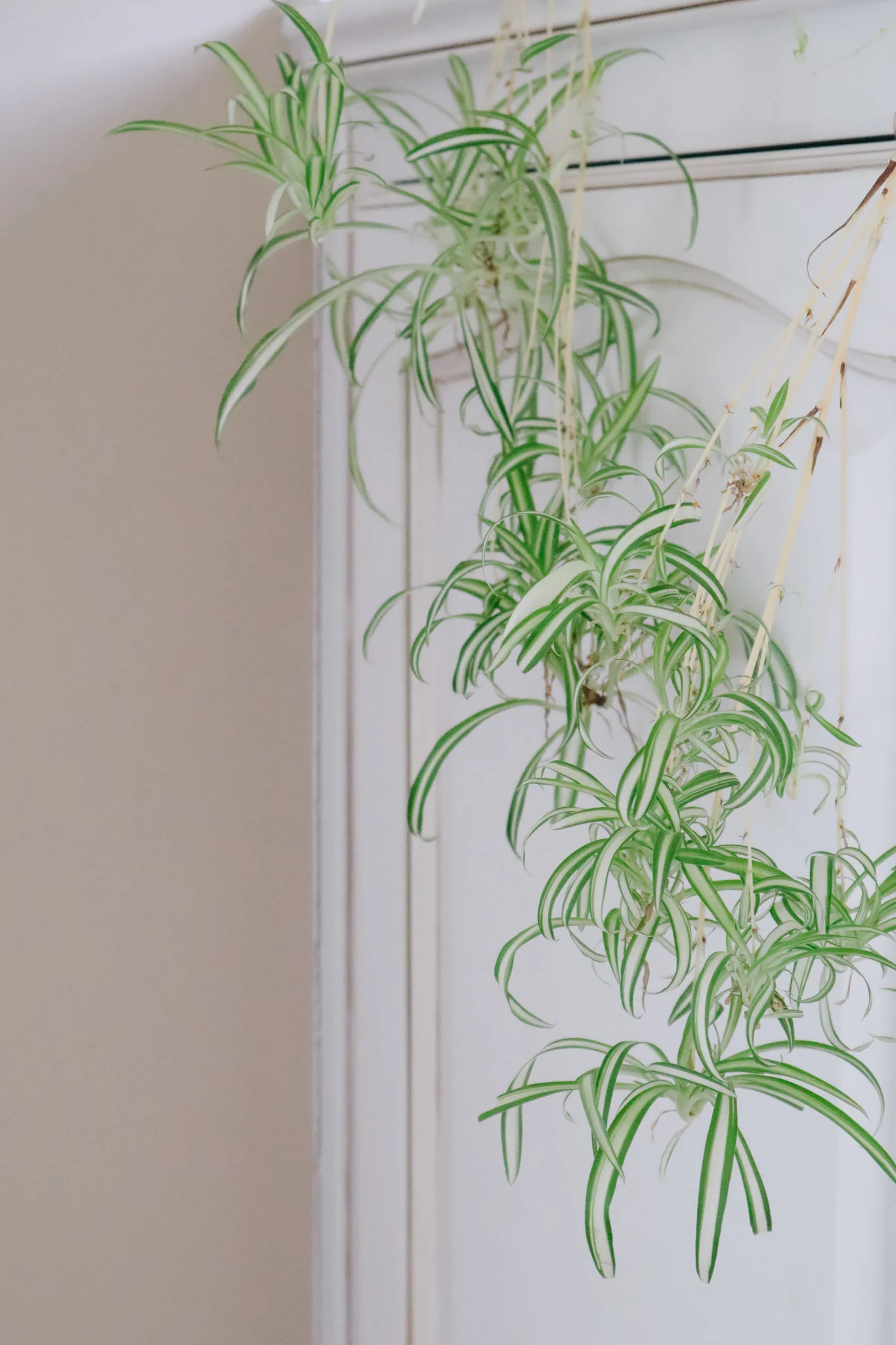{Painted} Green Thumb
Published in Lee’s Summit Lifestyle and Johnson County Lifestyle March 2021
*Silvertooth Home participates in affiliate programs. This means that if you click or make a purchase from links on this page, Silvertooth Home will receive a small commission at no extra cost to you. Thank you for for supporting us in this way.
Plants for Beginners
I am obsessed with plants! But, truth be told, I have a painted green thumb. This can be translated as “having a love for plants, killing some while successfully growing others.” I confess that in spite my best efforts, I cannot keep orchids, ferns or succulents alive for more than a few weeks. I can, however, grow some things and do so very well! I can’t wait to share with you the plants that have lived in my home for over 15 years… successfully!! If you’re new to the plant world then I hope knowing that about me gives you the courage to try your hand at growing too. So, paint your thumb green (hypothetically!) and join me @silvertoothhome as we grow things together.
General growing tips for the beginner… 1) The Seasonal Cycles are not just in the outdoor plant world! Did you know that indoor plants go through seasonal cycles too? Indoor plants require regular water and fertilizer in the summer and then go through a dormant period in the winter requiring minimal water and fertilizer. My seasonal rhythm is to treat Oct-February as dormant months and March-Sept as growing months. 2) Watering: The number one way folks kill their plants is by overwatering. Don’t be a wet blanket! Literally. Make sure to test your soil (with your finger or this little tool) before watering to make sure that you don’t over do it. Soggy soil kills. It helps me to pick one day of the week as watering day so I don’t accidentally overdo it. I’ve been doing Water-Wednesdays for years! As a general rule, water 1x per week in the growing months and 1-2x per month in the dormant months. Finding an app such as Planta (free) or setting an alarm reminder on your phone can also help to manage your itch to overwater. 3) Fertilizing is key. We don’t live on water alone and the same is true with plants. Plants need water AND food to thrive! I use a general indoor liquid plant food and simply add to my plants water as recommended on the label. 4) Double pot your plants to avoid root rot as well as having water leak onto your floors and shelves. Keep your plant in a plastic pot with drain holes and then place that pot into a larger pot without drain holes. Now everyone is happy! Also, repot your plant yearly (or as needed) as they outgrow the current one lived in. 5) If bugs and fungi creep in then spray my plants with Neem Oil according to directions. I’m not going to lie, this stuff stinks like crazy. But, it takes care of a multitude of problems without the use of chemicals and your plants will thank you.
My favorite plants (because I don’t kill them)
{Purple} African Violet
This was the very first house plant that I tried to keep alive as a newly married homemaker. I still have the original African Violet plant that my mother-in-law gave me 15 years ago. That alone should prove how easy they are to love. Afrian violets produce small colorful flowers that range from purple, pink and multi color. Just make sure you don’t drip water on their leaves or let the leaves get direct sunlight as both will burn them. If you do burn a leaf, simply pinch it off and your plant will grow a new one. Easy.
LIGHT… bright-indirect light.
WATER… require bottom-up watering so use a self watering pot, refill as needed.
FERTILIZER… this is the only plant that I use a fertilizer specifically for its species (I use general indoor fertilizer for all of my other plants). I like to use a liquid version by simply adding it to the water when refilling their pots.
CARE TIPS… avoid getting leaves wet as water burns their leaves. Pinch off dead flowers and overgrown leaves to force more blooms. Mature plants may be split to multiply your herd!
Croton
I’ve almost killed this plant-baby several times over. Fortunately, it forgives easily and with simple adjustments to light and water it always comes back to love me! I just adore the technicolor leaves and the more light you give them the more colorful they become! If you’ve been to the south you probably have seen them in outdoor landscaping. Here in Kansas City it is too cold for that but they do wonderfully for us indoors especially if pulled outdoors in the summer.
LIGHT… bright-indirect light or bright-direct sun (the more sun, the more colorful their leaves become!).
WATER… medium demand watering (top layer of soil should be dry before watering again).
FERTILIZER… add liquid indoor plant fertilizer to your water as directed on the label. Stop fertilizing in dormant months.
CARE… Croton may need support as they get larger. I like to use bamboo stakes and plant velcro. You can move your Croton outdoors in the summer months.
Dracaena
This giant plant is a statement, for sure. Mine is 6ft tall and still growing! If you watch The Office then you might have noticed that a Dracaena cameos in many of the character’s interviews! I move mine outdoors during the summer months and it goes crazy with new growth.
LIGHT… bright-indirect light or shade.
WATER… low demand watering (let the soil completely dry before watering).
FERTILIZER… add liquid indoor plant fertilizer to your water as directed on the label. Stop fertilizing in dormant months.
CARE… older bottom leaves will yellow and die as new ones grow on top. Gently remove yellow leaves directly from the plant or wait until they drop.
Fiddle Leaf Fig
This is included in my favorite list but be warned as they are a bit finicky. Make sure to not let the leaves see direct sunlight or they will burn and occasionally rotate so it grows up straight. And, if all else fails, get a faux Fiddle Leaf Fig! Your guests probably won’t know the difference.
LIGHT… bright-indirect light. Direct light will burn the leaves.
WATER… medium demand watering (top layer of soil should be dry before watering again).
FERTILIZER… add liquid indoor plant fertilizer to your water as directed on the label. Stop fertilizing in dormant months.
CARE… every few months wipe off leaves so your plant can successfully photosynthesis (science!). Use a microfiber cloth to dust or wet a paper towel with a drop of olive oil and shine them up. Your Fiddle will thank you! In addition, Fiddles will grow towards the light so rotate as needed in order for them to grow up and not sideways.
Pothos
In my opinion, the easiest indoor plant to grow is a Pothos! If you don’t try to grow anything else, try to grow this dramatic vine!! Pothos are by far my favorite for trailing vines up walls (tip: hold up vines on walls with adhesive hooks) or draping them down mantles. These babies require minimal light and forgive you for forgetting to water them.
LIGHT… shade to indirect light.
WATER… medium demand watering (top layer of soil should be dry before watering again). Pothos are so easy that sometimes I wait until their leaves wilt a bit to tell me it's time to water. Once they get a drink they spring right back up!
FERTILIZER… add liquid indoor plant fertilizer to your water as directed on the label. Stop fertilizing in dormant months.
CARE… if your pothos grow too long then cut off their vines and place them in water to grow a new plant. I love to place these cuttings in wall hanging vases for a little wild touch in a room.
Snake Plant
You’ll appreciate that this guy is extremely hardy and doesn’t like a lot of attention. Give him lots of space, don’t over water, and whisper when you’re in the same room (just kidding).
LIGHT… bright-indirect light.
WATER… low demand watering (let the soil completely dry before watering). If you kill this plant it is most likely from over watering. Letting it dry up between waterings is the key to success!
FERTILIZER… add liquid indoor plant fertilizer to your water as directed on the label. Stop fertilizing in dormant months.
CARE… No extra work required! Wipe off leaves if they become dusty.
Spider Plant
A close second to Pothos, this one has a high success rate for beginner growers. I think it looks so whimsical with all the little spiderettes hanging from the mother plant. I especially love when it produces its dainty white blooms in the spring. Our kids get a kick out of cutting the “baby spiders” from the mother plant, placing them in water and watching as the new plant grows roots. Bonus: not only is this plant non-toxic, studies by NASA prove that they reduce indoor air pollution as well. Nice!
LIGHT… bright-indirect light to bright light.
WATER… medium demand watering (top layer of soil should be dry before watering again).
FERTILIZER… add liquid indoor plant fertilizer to your water as directed on the label. Stop fertilizing in dormant months.
CARE… I like to remove any dead leaves when I see them. Although brown leaf tips are common and will not harm the plant, I like to cut them off to freshen up its look.
Monstera
Along with Fiddle Leaf Fig, the Monstera is a trending plant in the home decor world. Nicknamed Swiss Cheese Plant for its natural splitting leaves. The younger the plant the less leaf splits (this one is a baby so doesn’t have the split leaves yet). In the wild the Monstera is a tropical vine that climbs up larger plants. Cool, huh?
LIGHT… bright-indirect light.
WATER… low demand watering (let the soil completely dry before watering).
FERTILIZER… add liquid indoor plant fertilizer to your water as directed on the label. Stop fertilizing in dormant months.
CARE… these plants can take over so prune as they grow. You can propagate your cuttings by placing them in water to create new plant babies.





































